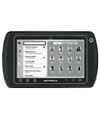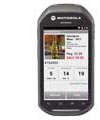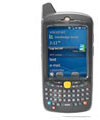« August 2013 | Main | November 2013 »
October 23, 2013
Two annoying trends
Today I am going to rant a bit about two trends that simply make no sense to me.
The first is "skeuromorphism." It's the new fashion word-du-jour, what with Apple and Microsoft demonising it as if it were some sort of evil plague. As is, Wiki defines skeuromorph as "a derivative object that retains ornamental design cues from structures that were necessary in the original." That includes, of course, many elements of graphical user interfaces. The desktop metaphor, after all, has been at the very core of every graphical user interface for the past 30 years.
But now that very quality, to make objects on a computer screen look just like the real thing, has come under heavy attack. And that even includes the three dimensional nature of the real world. Apple, especially, but also Microsoft, now want everything to be flat. As flat as possible. Anti-skeuromorphism forces argue that the public has now been exposed to computers long enough to no longer need the analogy to real, physical things. And so, in the eyes of many, the latest versions of many operating environments, and Apple's iOS, look dreadfully flat and barren indeed.
In Apple's case, one could well argue that a bit of a backlash against skeuromorphic excess was probably a good thing. Apple, long the champion of good design, had begun slipping with some truly kitschy stuff, like the "leather-bound" address book, the Ikea-style wooden bookshelf and other affronts that likely would have had a healthy Steve Jobs froth at the mouth. So a bit of streamlining things was in order, but when I look at the sad, sparse, flat expanse and eensy-tiny lettering that now mars the iOS and many of its apps, the sad icons that look like they just want to vanish from view, and the rest of the bleakness that now adorns iPhones and iPads, I wish Jonathan Ive and colleagues would have stuck with hardware.
You could argue, of course, that after decades of visual improvements and fine-tuning, the anti-skeuromorphism crusade simply rings in the advent of fashion in electronic interfaces. Just like fashion goes into extremes just to then denounce the trend and swing into the other extreme (neatly obsoleting billions of dollars worth of product in the process), perhaps we'll now have to put up with anemic, flat computer and tablet screens until the trend reverses and everything becomes three dimensional and lively again.
Okay, the second trend is that to thin and slender hardware design at all cost. The just announced new Apple iPad Air is hailed as a wondrous achievement because it's thinner yet and weighs even less. It's a veritable Barbie of a tablet. And since this is Apple, and Apple decreed some years ago that computing devices need to be rectangular and very flat, we now have hyper-slim smartphones, hyper-thin tablets, and even hyper-thin iMacs, which in the latters' case makes absolutely no sense since they sit on a desk in front of you. And we also have hyper-thin HDTVs. Size is okay as we now have smartphones with screen sizes approaching 6 inches and flat screen TVs approaching 90 inches. But it all must be very flat and thin.
Why?
I mean, making that technology so very flat simply makes it more difficult to design and manufacture, and since hardware happens to be a physical thing it often loses utility if it's pressed into too flat of a design (the new iPad Air's battery is down to 32.9 WHr, vs. the iPad 4's 43 WHr). The dreadful sound of flat-screen TVs is a prime example, and the so-so battery life of many super-slim smartphones another. More and more the trend to supreme thinness seems more a narcissistic quest to prove that one's technology is so advanced that mere physicality no longer matters. Sort of like a supermodel starving herself into a skeletal, gaunt appearance just to be lauded for her discipline and elegance.
It makes no sense. I mean, the latest Crossover probably weighs almost 5,000 pounds, a house weighs an awful lot, and American people weigh more all the time, too. So why is ultimate thinness in an electronic device such a virtue?
And it especially makes no sense for rugged devices where the very physicality of the design provides the structure and toughness to make it last on the job. And where a degree of volume means it'll run cooler and provide space for expansion and versatility. Yet, even rugged device are getting thinner all the time. They have to, or the public, even customers in enterprise and industrial markets, will stay away.
So there, two silly trends. And trends they are, as you can't keep making physical stuff thinner beyond a certain point. Once that point is reached, the quest is over, and the pendulum will reverse or go elsewhere. It's quite possible that the next Steve Jobs will some day present the latest super-gadget, and it will be egg-shaped. It's possible.
Be that as it may, I just hope that technology will stay as free from fashion dictates as possible. Because once it takes fashion to sell gear, that means innovation is over.
Posted by conradb212 at 8:21 PM
October 18, 2013
Rugged Android device comparison table, and contemplations over Android in the rugged market
On October 18, 2013, RuggedPCReview.com launched a rugged Android device comparison table. The table allows interested parties to view full specifications of all rugged handhelds and rugged tablets we're aware of.
Given the absolutely massive number of Android devices activated worldwide -- about a billion -- it's amazing how few rugged Android devices are available. As we recently reported, both Honeywell/Intermec and Motorola Solutions have launched initiatives to make rugged Android devices available to industrial and enterprise markets, and other manufacturers are offering ruggedized Android-based handhelds and tablets as well. But there aren't many actual devices, probably less than a couple of dozen in both categories combined. And even that small number includes products that are available with either Android and one version of Windows Mobile or another, which means they aren't really optimized for either.
Add to that the fact that few of the available Android-based rugged devices are on the latest, or even a recent, version of Android, and that much of the hardware isn't anywhere near the technological level of consumer smartphones and tablets, and one has to wonder all over again why Android has such a terribly hard time to get going in rugged/industrial devices.
On Microsoft's website you'll find a white paper entitled "Choose Windows Mobile Over Android for Ruggedized Handhelds" written by Gartner in February 2011 (see here). Among the key recommendations there were to "remain with Windows Mobile for ruggedized handheld-computer solutions, and to prepare for a transition to full Windows in subsequent implementations" and to "limit the scope of Android-based ruggedized application development through 2013." Of course, the two and a half years since Gartner issued the paper is an eternity in mobile electronics. At the time they still mentioned Android as the #2 smartphone OS behind Symbian!
Gartner also cautioned that the lack of FIPS-140 compliance (FIPS 140 is a U.S. government computer security standard that specifies cryptographic requirements) was an issue for Android, and they predicted that enterprise software vendors would probably create HTML5-based client applications with cross-platform abstraction layers to provide some support of Android devices. FIPS-140 compliance was indeed an issue with Android, and one that's even now still only addressed on a by-device level. Cross platform application development is now available via platforms such as RhoMobile and iFactr.
I don't know how widely read Gartner's 2011 report was, but over the past three years the rugged computing industry certainly heeded Gartner's advice of choosing Windows Mobile over Android for ruggedized handhelds. Gartner's 2011 arguments made sense, but probably even Gartner didn't foresee that the installed base of Android devices would grow from under 200 million back in 2011 to a cool billion today. One could easily argue that playing it safe with Windows Mobile precluded participating in the rapid, massive learning curve with Android over the past two or three years.
There are no good answers, and hindsight is always 20/20. Except that even two or three years ago it was quite obvious that Windows Mobile was doomed, and Microsoft did not seem to have a compelling roadmap in the mobile space. In historic terms, the predicament the rugged handheld and tablet manufacturers have been facing over the Android issue is no less harrowing than the predicament they faced a decade and a half ago when there was increasing pressure to abandon their various proprietary operating platforms in favor of Windows CE.
What's the answer? Hard too say. It is impossible to ignore a user base of a billion and counting, because that billion already knows Android and how it works. On the other hand, Android's fragmentation is vexing, there remain questions about platform security (see overview of Android security), and the fact that Android' was as clearly designed for capacitive multi-touch as Windows was for a mouse makes it less than perfect for gloves and wet places. At this point it is also still possible that Microsoft might somehow pull a rabbit out of its hat with Windows Embedded 8 Handheld, causing a percentage of the rugged mobile market to go one way and the consumer market another. Remember that the Palm OS once dominated the mobile OS market to an extent where Symbol (now part of Motorola Solutions) had a Palm-based industrial handheld (see here) before the tide went the other way.
Posted by conradb212 at 6:28 PM
October 2, 2013
October 1, 2013 -- the day Moto Solutions and Honeywell/Intermec became serious about Android
This has been quite the day for Android in the rugged handheld space.
Intermec, now part of Honeywell Scanning & Mobility, announced the CN51 rugged mobile computer. It is an updated version of Intermec's successful CN50, but has a larger, higher resolution screen (4.0-inch, 800 x 480) that now uses resistive multi-touch, updated WiFi, WAN, Bluetooth, camera, and scanners, and it's now based on the dual-core 1.5GHz TI OMAP 4 processor, which means Intermec can offer the CN51 either with Microsoft Windows Embedded Handheld 6.5 OR with Android 4.1.
And Motorola Solutions, the same day, announced that three of its popular enterprise mobile computers would now be available with Android Jelly Bean, fortified with Moto's own Mx security, device management and performance features that they added to the standard Android OS. So as a result, the following three Motorola Solutions devices will now be available with Android Jelly Bean:
| Motorola Solutions Android mobile computers |
| Product | ET1 | MC40 | MC67 |

|

|

|
|
| Type | Enterprise tablet | Rugged Handheld | Enterprise PDA |
| Display | 7-inch (1024 x 600) | 4.3-inch (480 x 800) | 3.5-inch (480 x 640) |
| Digitizer | Capacitive multi-touch | Capacitive | Resistive |
| Original OS | Android | Android | Embedded Handheld 6.5 |
| Available OS | Android Jelly Bean | Android Jelly Bean | Android Jelly Bean |
| RAM | 1GB | 1GB | 1GB |
| Storage | 4GB Flash + microSD | 8GB Flash | 8GB Flash |
| Size | 8.8 x 5.1 x 1.0 | 5.7 x 2.9 x 0.8 | 6.4 x 3.0 x 1.3 |
| Weight | 1.4 lbs. | 9.4 oz. | 13.5 oz. |
| CPU | 1GHz OMAP 4 | 800MHz OMAP 4 | 1GHz OMAP 4 |
| Scanning | via 8mp camera | SA4500-DL | SE4500-SR/DL/DPM |
| WWAN | Data-only | NA | Voice and data |
| Op. temp | 32 to 122F | 32 to 122F | -4 to 122F |
| Sealing | IP54 | IP54 | IP67 |
Motorola Solutions points out that their three Android offerings are not only benefitting from the Mx extensions (see Mx website), but also from the company's RhoMobile Suite (see RhoMobile page), a cross-platform development tool used to create apps that are OS-independent. Which means the Moto Android devices can run standard Android apps, or HTML 5 cross-platform apps created with RhoMobile.
Here's what Motorola Solutions had to say about the emerging Android devices:
And below is Intermec's introduction to their CN51 that can run both Windows Mobile and Android:
What does it all mean, this pretty high visibility push of Android in business and enterprise class devices? Well, there's the odd situation that while almost all smartphones are either iPhones or Android devices, virtually all industrial handhelds still run one version of Microsoft's old Windows CE or Windows Mobile or another. Which means that most industrial handhelds are by no means ruggedized equivalents of the smartphones a good part of humanity already knows inside out. Which results in extra training, an extra learning curve, and the near certainty that change will come anyway. Up to now, rugged mobile computing manufacturers have been remarkably conservative in acknowledging that trend, and generally limiting themselves to offering an exploratory Android version or two of a Windows device running on similar hardware. What we're now beginning to see is the next step, that of making the hardware so that it can run both old and new.
Now, no one wants to alienate Microsoft, of course, and so things are worded carefully. Intermec's press release includes a quote from industry analyst David Krebs, VP of mobile & wireless at VDC: "While rugged devices are designed to be more function or application-specific than smartphones, there is growing consensus that these devices deliver a similar immersive experience and have similar capabilities as function-rich smartphones. As Android matures in the enterprise it represents an increasingly viable option for rugged vendors such as Intermec to bridge this functionality gap and deliver the capabilities their partners and customers are looking for."
On the Motorola Solutions side, Girish Rishi, Senior VP of enterprise solutions, said, "Now, businesses have more choices and can better manage rapid changes in the market by using Motorola’s tools that deliver complete solutions in less time while protecting their mobile investments.â€
It's fairly safe to assume that these are just first steps. The proposed hardware still represents compromises and is not (yet) truly Android optimized. But the message communicated by both Intermec/Honeywell and Motorola Solutions is quite clear: We can't wait any longer, Microsoft. We need to get with the program before we lose our markets to consumer smartphones in a case.
Posted by conradb212 at 12:09 AM
















